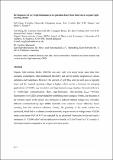Development of very high luminance p–i–n junction-based blue fluorescent organic light-emitting diodes
Abstract
Organic light‐emitting diodes (OLEDs) can emit light over much larger areas than their inorganic counterparts, offer mechanical flexibility, and can be readily integrated on various substrates and backplanes. However, the amount of light they emit per unit area is typically lower and the required operating voltage is higher, which can be a limitation for emerging applications of OLEDs, e.g., in outdoor and high‐dynamic‐range displays, biomedical devices, or visible‐light communication. Here, high‐luminance, blue‐emitting (λpeak = 464 nm), fluorescent p–i–n OLEDs are developed by combining three strategies: First, the thickness of the intrinsic layers in the device is decreased to reduce internal voltage loss. Second, different electron‐blocking layer materials are tested to recover efficiency losses resulting from this thickness reduction. Third, the geometry of the anode contact is optimized, which leads to a substantial reduction in the in‐plane resistive voltage losses. The OLEDs retain a maximum external quantum efficiency of 4.4% as expected for an optimized fluorescent device and reach a luminance of 132 000 cd m−2 and an optical power density of 2.4 mW mm−2 at 5 V, a nearly eightfold improvement compared to the original reference device.
Citation
Deng , Y , Murawski , C , Keum , C , Yoshida , K , Samuel , I D W & Gather , M C 2020 , ' Development of very high luminance p–i–n junction-based blue fluorescent organic light-emitting diodes ' , Advanced Optical Materials , vol. Early View , 1901721 . https://doi.org/10.1002/adom.201901721
Publication
Advanced Optical Materials
Status
Peer reviewed
ISSN
2195-1071Type
Journal article
Description
This research was financially supported by the EPSRC NSF‐CBET lead agency agreement (EP/R010595/1, 1706207), the DARPA‐NESD programme (N66001‐17‐C‐4012), and the Leverhulme Trust (RPG‐2017‐231). Y.L.D. acknowledges a stipend from the Chinese Scholarship Council (CSC). C.M. acknowledges funding by the European Commission through a Marie Skłodowska Curie Individual Fellowship (703387). C.K. acknowledges support from the Basic Science Research Program through the National Research Foundation of Korea (NRF) funded by the Ministry of Education (2017R1A6A3A03012331).Collections
Items in the St Andrews Research Repository are protected by copyright, with all rights reserved, unless otherwise indicated.

